Poles treated the role of defenders of the bulwark of Christianity seriously. Instead of mentioning Varna and other defeats, it is worth talking about the triumphant skirmishes. Because our ancestors showed at least five times that "Pohaniec" can be beaten. And so that it would go all the way to his heels.
The beginnings were difficult. On November 10, 1444 near Varna, the army of the Turkish Sultan Murad II was outnumbered. However, the Polish-Hungarian army under the command of the Transylvanian voivode, Jan Hunyady - called by the Turks "Cursed John" - and King Władysław III - called "Varnański" from the end of this battle - fought very efficiently. It seemed as if they would slip out of the trap and be victorious. The fate of the clash was vividly portrayed by Maciej Siembieda - the author of the intriguing novel "444" :
Hunyady was the master of the situation. Standing in the stirrups, he looked at the battlefield for the twelfth time and suddenly he clutched his head as if he had been hit by a blow:King Władysław, who was to wait for the final blow of the heavy cavalry - if it would be needed at all - arbitrarily set off with the banners for the Janissaries.
Cursed John managed to shout "No!" until the terrified horse reared under him, but it was just a cry of despair. The armored cavalry crashed into the infantry square surrounding the Sultan and even made a breach in it, but for the Janissaries it was child's play to master the ill-considered charge. They stabbed the horses with their spears, and when they fell, throwing the riders - they killed the lying ones with a single thrust of the scimitar. In fact, it took two moves to take down the iron-bound steed and the knight in full armor.
The king's mount - struck by an arrowhead - also hit the sand with his front knees, and a rider in shining armor flew over his neck and fell a meter away. A few Turkish walkers started walking towards him, but they were stopped by the scream of a huge janissary in a red kierei:
- Stop! He is mine!
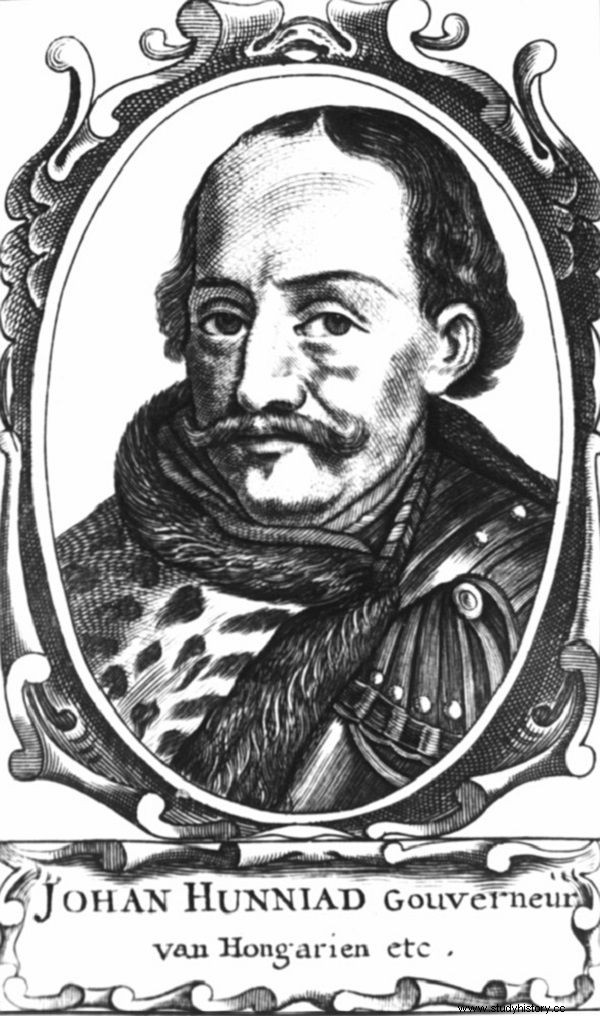
Cursed John, who was watching from the side of the battlefield, was unable to stop the thoughtless charge of the Polish king.
They went backwards. The shining knight with the closed visor managed to get up at that time, and then the Codja Chazer, despite its huge size, jumped up to him with feline dexterity and with one move of his saber cut off his head. There was a deafening roar of triumph over the center of the battle.
OK, in fact, we did not do well that day near Varna. King Władysław gained his nickname, eternal knightly fame and gratitude (for the efforts, but not for the effects) of the Slavic peoples oppressed by the Ottoman Turks, but he lost his crown, power, life and head, which was taken to the Turkish capital. Balance a bit troublesome.
The bulwark of Christianity
Nine years later, Constantinople fell and a new era began in the history of Polish-Turkish contacts. In general, they were quite appropriate, and in 1533 Sigismund the Old and Suleiman the Magnificent even concluded a perpetual peace treaty, which translated into the Mediterranean, where the Sultan forbade attacking ships and the property of the Duchy of Bari - the ancestral estate of the Polish king's wife, Bona Sforza.
But sometimes it sparked. Most often, when the Tatars and Cossacks, who were formally subordinated to the Commonwealth, started their plundering operations. Fights also took place in Moldova, where Polish magnates tried their policy, and the still existing Barbican is a reminder of the real threat of a Turkish attack on Krakow. In fact, the situation between the two countries worsened when King Zygmunt III sent a unit of Lisów to help the Habsburgs, which the Turks considered to help their enemies. The first of a series of wars broke out.
The fortune of war favored one or the other, but on several occasions our southern neighbors under the sign of the crescent learned all too clearly what it meant to tear at the bulwark of Christianity. Of course, there were more such ramparts - any country bordering with a foreign culture or religion could take such a name, but let's focus on what is ours. And let's recall a few places and dates that the Turkish military would prefer not to remember.
Khotyn for the first time
The beginning of the war with Turkey in 1620-21 was not the best - we lost the Battle of Cecora, where Hetman Stanisław Żółkiewski, commanding the Polish army, died. Cheerful with success, 17-year-old Sultan Osman II planned to finish the work - to take Poland to the Baltic Sea and destroy the Habsburgs in the Thirty Years' War.
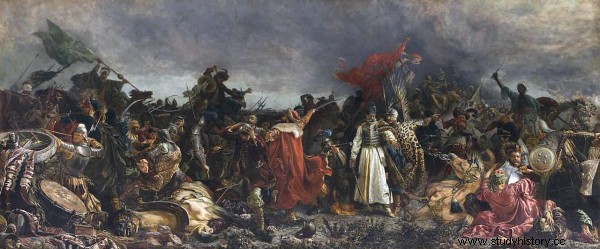
The Battle of Cecora ended with the defeat of the Republic of Poland and the death of Hetman Żółkiewski. Picture taken by Witold Piwnicki.
He should have forgotten, however, when there was a solar eclipse on the day his troops left. He did not let go and the battle took place near Chocim, where 25-26 thousand soldiers were commanded by the Lithuanian Grand Hetman Jan Karol Chodkiewicz and 20-30 thousand Cossacks led by Hetman Piotr Konaszewicz Sahajdaczny in the fortified camp. Soon they were besieged by 100,000 Turkish troops, a power against which Europe trembled. From September 2, fighting continued, the Turks even managed to break into the Polish camp, but the counterattack of the cavalry led by the hetman himself pushed them beyond the embankments. The pact was signed on October 9, 1621.
Who knows what the fate of the battle would have turned out to be if the ailing Polish hetman did not die during the siege. However, the end of the war was caused by shortages of food, fodder and war materials, which plagued both sides. Until the negotiations were started, the Turks lost 40,000 dead and dead, and the Poles and Cossacks in total 14,000 died, died of starvation and disease, and deserters.
After the defeat, the Turkish Sultan Osman II wanted to reform the Janissary corps, which he accused of cowardice. However, it was the subordinates who showed cunning, initiative and determination - imprisoned their ruler and murdered him.
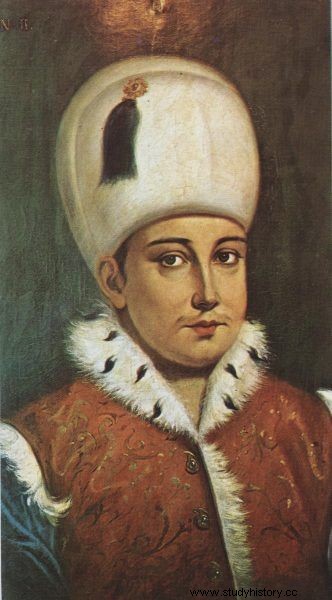
Osman II wanted to reform the Turkish military. He did not make it in time, he was murdered.
Chocim for the second time
The beginnings were bad again - in 1672 Mehmed IV captured Kamieniec Podolski and besieged Lviv. In Buczacz, the Republic of Poland gave up part of Ukraine and Podolia with Kamieniec. Such a disgrace, however, was not ratified by the Seym and passed taxes on the army.
This time, the Poles attacked the Turks near Khotyn. The forces were balanced - both sides had approx. 30 thousand. cavalry and infantry. Although the Poles were exhausted by the 300-km walk and the lack of supplies, they had a qualitative advantage, because they were commanded by the Grand Hetman of the Crown, Jan Sobieski. He knew the art of war like hardly anyone, and according to Paweł Jasienica, “He invited November as an ally. The night, an icy wind and sleet was a torment for Poles and Lithuanians, a death torture for the Turks. "
Throughout the night of November 10-11, 1673, the Polish artillery fired, and the trumpeters played until the assault. This one was not coming, but a frosty night with raging snowstorm thinning the ranks of the Turkish defenders and exhausting those who remained at their post.
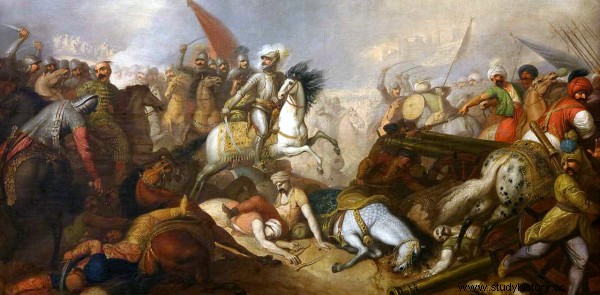
Another battle of Khotyn in the 17th century and another success of the Polish-Lithuanian Commonwealth. Painting by Franciszek Smuglewicz.
When in the morning another signal brought a real attack, the Moldovan allies of the Turks fled, and the Polish infantry captured the embankments and dug them up to let the cavalrymen enter the camp. Then, despite Turkish counterattacks, the work was completed, and the rest was completed by the attack of the hussars. Another misfortune faced the Turks - under the pressure of the fleeing people, the only bridge on the Dniester in Khotyn collapsed. Turkish losses were significant.
Interestingly - the victory took place on the anniversary of the Battle of Varna. It brought plentiful loot, and the camel population in Poland increased significantly. Jan Sobieski was respected by the Turks as "The Lion of Chocimski", but unfortunately he did not finish the job - just before the battle, King Michał Korybut Wiśniowiecki died, and the victorious hetman went to a free election as a candidate for the future monarch.
How the mortar scared Szejtan
The skirmishes at Żurawno (sometimes written:Żórawne) fought in the forks of the Dniester and Krechówka in Ukraine between September 25 and October 14, 1676 cannot be compared with the great battles fought by the Polish-Lithuanian Commonwealth. However, it is worth bringing it closer due to an interesting stratagem used by Poles. The Turkish-Tatar army, led by the Pasha of Damascus, Ibrahim Sheitan and Khan Selim Girej, had 40,000 men and had two times advantage over the Poles who, under the leadership of King Jan III, took refuge in a fortified camp.
After the first unsuccessful and bloody assaults, the Turks began a siege and limited themselves to the cannon fire. The fire was intense, causing great losses, and the defenders ran out of food and feed. Yes, the fire of Polish artillery also caused heavy losses in the Turkish ranks, but it was only when the defenders attracted an old mortar from a nearby castle and opened fire from it caused Turkish anxiety. Well, the Turks knew that Poles did not have mortars, so a new type of artillery weapon caused them a serious fear that the Polish relief had come. The ceasefire was quickly concluded, and three days later, on October 17, the truce was signed. This is how the devilish trick with the old mortar scared Ibrahim Sheitan ...
Vienna - a triumph known in the world
This time it was a battle that should definitely be defined by Lord Edgar Vincent D'Abernon as one of the decisive battles in the world. The Polish king - called with hatred by the Turks "the curse by the name of Sobieski" - set off with the Crown army in the strength of 27,000 cavalry and 27 guns to help the Habsburgs.
Poland was part of a wider coalition composed of Austrians, Bavarians, Swabs, Franconians and Saxons. Their goal was to free the capital city of Vienna, which was besieged by over a hundred thousand siege army led by the vizier Kara Mustafa. This one might have crushed the city's resistance earlier, but he wanted to lead to its surrender, not to settle the matter with an attack. It was not about saving his soldiers, but about the fact that the capitulation of the fortress gave the commander the right to loot, and the taking of it by storm - the soldiers.
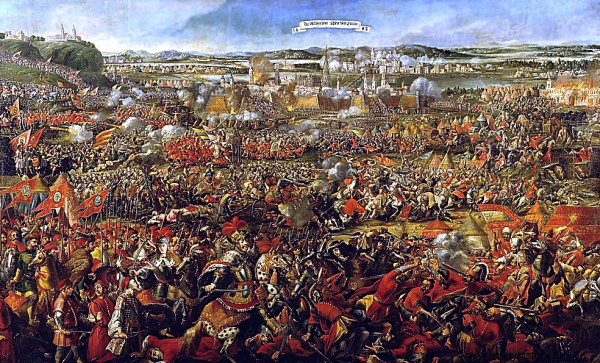
The Battle of Vienna - one of the greatest Polish triumphs in history. Author unknown.
When the relief came, the Turks left some of their troops in the siege ramparts, and some tried to stop the allied forces commanded by the Polish king. The forces were even - 60,000-80,000 men and 70 Turkish cannons against 70,000 men and 80 Christian divisions. First, the Austrians, led by Prince Charles of Lorraine, attacked, then the Germans, led by Prince Georg Waldeck. At the end, the main blow came - first the Polish infantry moved from the right wing, then the light cavalry explored the area, and finally the hussars and the rest of the allied cavalry went into battle. There was no force to stop this momentum. The invaders lost 10-15 thousand soldiers in the battle, the allies - 15 thousand (in total during the fighting and siege), but the defeat of the Turks was unquestionable. They lost not only the camp, but an almost certain victory.
The rich loot fell into the hands of the winners, many of the participants of this victory became a true master. The victory became famous throughout Europe, a national liberation movement developed in the Balkans, and the Turks began their retreat towards the Bosphorus. The captured coffee served in a cafe appeared in Vienna, and the king gained the gratitude of the Viennese and the name of the "Lion of Lechistan" by the Turks.
Vienna was saved, and the Turks' plans to occupy Central Europe had to be hidden deep in the archives. Although, unfortunately, Poland did not take any tangible profits from it.
Last Chord - Parkany
There were actually two battles. In the first, played on October 7, 1683, the Turks triumphed, followed by King Jan III Sobieski after his victory at Vienna. From a small clash at Parkany in Hungary to the great misfortune was very close. It was enough that the front guard made a mistake, and then suddenly panic broke out in the Polish ranks and the army fled. The king himself escaped with him, saved at the last moment from an attack by Turkish spahis by an unknown soldier. The pursuit turned back only at the sight of the imperial cuirassiers. Poles lost one and a half thousand people.
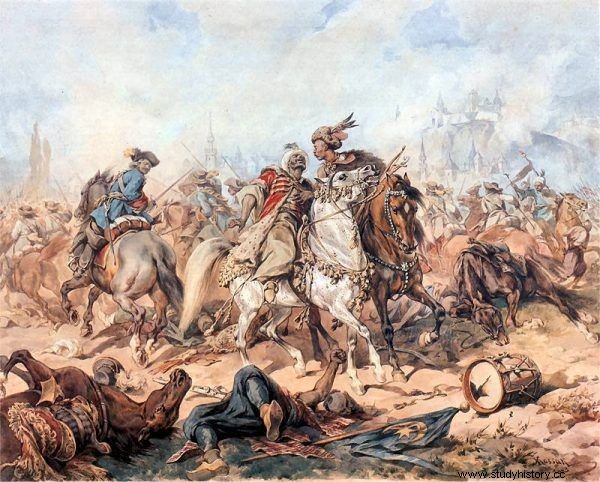
This is how Juliusz Kossak presented the battle of Parkany.
Two days later, the king took his rematch almost exactly at the site of his defeat. The Turks had 36,000 troops, and Poles and Austrians - 31,000. Despite the numerical superiority and great courage, the Sultan's army did not break the front. When the invaders had exhausted all their reserves, the Polish cavalry started the attack, the impetus of which the Turks could not stand up again, and they launched a panic escape over the bridge.
This bridge, in turn, could not bear the weight either. Part of the Turkish army was cut down, part drowned, and the whole thing practically ceased to exist. Only 1,200 people survived the pogrom.
The Commonwealth's wars with Turkey lasted until the peace treaty in Karłowice was signed in 1699. For the next 220 years, Turkey was pushed out of Europe, but in the end she did not let go of it completely. It adopted the Latin alphabet and joined NATO. And in the meantime - despite the difficult history - it was the only country in the world that did not recognize the partitions of Poland, and its rulers throughout the 19th and 20th centuries waited for an envoy from Lechistan to arrive.
